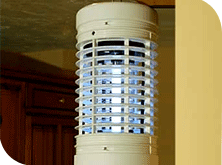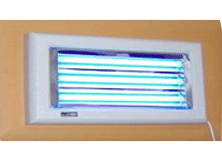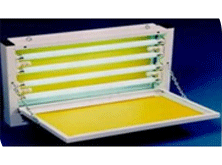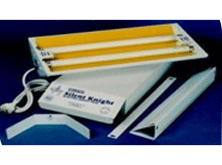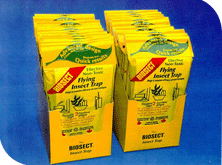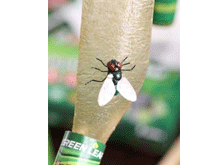Flies
- All flies belong to the insect order Diptera, which means two wings.
- All flies undergo complete metamorphosis with egg, larva, pupa, and adult stages in their development
- Flies perform a vital function as decomposers of dead organisms, manure and decaying vegetation
- Flies may act as carriers of disease organisms present in their breeding and egg-laying sites
- These disease organisms can cause food poisoning, diarrhea, dysentery or typhoid fever

Types of Flies
Blow Fly

- Adult flies are metallic blue, green, copper or black colored flies that otherwise resemble house flies in appearance
- Common species include the greenbottle flies (Lucilia spp.), black blow fly (Phormia regina), and various Calliphora species
- Lay their eggs on the carcasses of dead animals, decaying meat or garbage that contains meat scraps
- Large numbers of blow flies occur when a dead animal – usually a mouse or squirrel – dies within the home
- Although such occurrences are unpleasant, they are usually short-lived and self-limiting, as the insects are only capable of breeding on freshly killed animals
House Fly
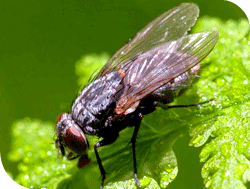
- The house fly is the most common fly pest around homes
- House flies generally are gray, with the thorax marked with four dark stripes
- Female flies lay numbers of eggs in suitable larval food sources such as decomposing food in garbage, animal excrement or other decomposing organic materials
- The adult flies feed on a wide range of liquid waste but can eat solid foods, such as sugar
- To digest solid foods, house flies liquefy food by regurgitating it and thereby are ideally suited to mechanically transmit disease organisms such as diarrhea and dysentery, to people
Stable Fly

- Stable flies are also called biting house flies
- The stable fly is a about ¼-inch long and gray with four dark stripes on its thorax
- This fly looks like a house fly, except for the pointed proboscis beneath its head through which it sucks blood
- They typically bite in early morning or late afternoon and often attack the ankles, inflicting a sharp, stabbing pain
- Stable flies lay eggs in piles of rotting vegetable matter, such as haystacks, grass clippings, manure and vegetation along shorelines
Flesh Fly
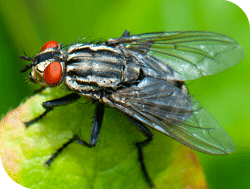
- Flesh flies are gray with three dark stripes on its thorax
- They are slightly larger than house flies and have a checkerboard pattern on the abdomen
- Flesh flies are attracted to sources of decay around the home, including garbage dumpsters, compost piles and dead animal carcasses
- Flesh flies are helpful in forensic entomology because they are usually the first to arrive at a carcass after an animal dies
- Flesh-flies can carry leprosy bacilli and can transmit intestinal pseudomyiasis to people who eat the flesh-fly larvae
Vinegar/Fruit Fly
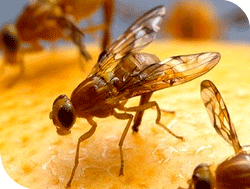
- Vinegar flies are small, slow-flying insects usually found in association with over-ripened fruit and vegetables, and are sometimes inaccurately called fruit flies
- Vinegar fly adults vary from 3 to 4 mm in length, have reddish eyes, are light yellowish brown to dark brown in colour, and may have darker markings on the dorsum of the thorax in the form of spots, blotches, or lines
- Vinegar flies are common nuisance pests in restaurants, grocery stores, fruit markets, canneries, homes, and other locations that may attract these insects with fermenting or rotting vegetative matter
Flies Management Mechanical Control
Electronic Insect Killer
Electric Insect Killers provide special fluorescent light tubes to attract flies, moths, mosquitoes and other flying pests to the interior of the units where they are electrocuted by the high voltage grids
Flying Insect Trap
Attract and trap flies and other insects pests such as moths, beetles, mosquitoes, midges, flying aphids and thrip Fluorescent yellow coloured sticky pads combine with UV rays emitted by tubes to create irresistible lure for flying insects
Fly Paper
Fly Paper is safe to hang in kitchens, on porches – anywhere around food, pets and people .Simply hang sticky fly traps with thumb tack or tape
Flies Management Chemical Control
Baiting
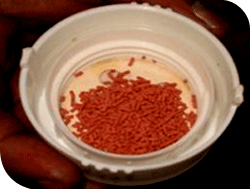
- Q-Bayt Fly Bait attracts and kills house flies in as little as 60 seconds
- Q-Bayt granules are easy to use and suitable for targeted application as a scattering bait or as a spreadable paste when dissolved in water
ULV Misting

- ULV misting should always be carried out during the adult insect’s time of peak flight activity which will usually be in the early morning for flies
- ULV droplets disperse evenly to contact and kill flies in flight and at rest
Fogging

- Fogging are effective in killing adult flies present at the time of application
- The chemicals used for these applications are usually short residual insecticides having a quick knock-down and high contact toxicity
- This method requires less time for application but has the disadvantage that it will only kill flies present at application and thus provides short-term relief
Residual Spraying

- Longer residual insecticides provide control for an extended period when sprayed onto sites where the adult flies congregate
- Sides of buildings, inside and outside surfaces of walls and fences may be potential day or night resting sites for these flies
- Flies contact the insecticide when they land on the treated surfaces



